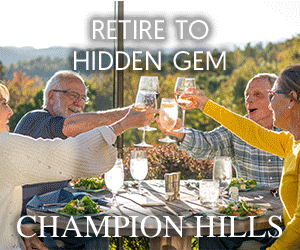In Steve Johnson’s 30-plus years of working in the golf industry, only once in his travels has he found a place as unique a golf destination as Pinehurst.
“The first time I went to St. Andrews I was struck by how alike the two places are,” said Johnson, regional general manager for Brown Golf Management, which purchased Foxfire Golf and Country Club and the Country Club of Whispering Pines in November 2012.
“They each have fabled courses (the Old Course at St. Andrews and Pinehurst No. 2) and both villages have a certain ambiance and quaintness about them. Life seems slower and more relaxed. And what’s really unique is how when you walk into a pub or restaurant they don’t ask how you’re doing, but ‘How did you play today?’ Golf is a way of life.”
Famed architect Donald Ross, who was the genius behind the iconic Pinehurst No. 2 design and other revered U.S. courses, will forever link the two towns. The Scottish-born Ross served as an apprentice to Old Tom Morris, an outstanding golfer and noted architect in his own right, who revitalized the Old Course in the late 1800s.
The comparisons between Pinehurst and St. Andrews end about there, though. While St. Andrews boasts numerous quality courses within a short distance of each other, it pales to what thrives in the Sandhills.
“The further away you get from North Carolina, the less people know about the area,” said Caleb Miles, president and CEO of the Pinehurst, Southern Pines, Aberdeen Area Convention and Visitors Bureau. “Some people are under the impression there is just Pinehurst Resort, but our role is to educate people that while Pinehurst Resort and its great courses is prominent, we are the ‘Home of American Golf’ for a reason.”
Actually there are 43 reasons — the number of courses within the Moore County borders. “You can’t find a better place where four guys want to get together and play golf,” Johnson said.
To help spread the gospel is the Sandhills Golf Association, which was incorporated in 1992 with the mission of attracting more golfers and enlightening the unaware. Today, the SGA numbers 19 courses totaling 23 18-hole layouts throughout Moore and neighboring counties.
The SGA is comprised of Anderson Creek Club, Bayonet at Puppy Creek, Beacon Ridge Golf and Country Club, Carolina Trace Country Club, Country Club of Whispering Pines, Foxfire Golf and Country Club, Hyland Golf Club, Legacy Golf Links, Little River Golf Resort, Longleaf Golf and Country Club, Mid South Club, Seven Lakes Country Club, Southern Pines Golf Club, Talamore Golf Club, The National Golf Club, Tot Hill Farm Golf Club and Woodlake Country Club.
The lineup of courses is formidable if only by the architects who designed them. Ross designed Southern Pines, which opened in 1906. Since then Ellis Maples, Arnold Palmer and Gene Hamm each designed 54 holes, while Robert Trent Jones, Dan Maples and Mike Strantz designed 36 each. Peter Tufts (great-grandson of James Walker Tufts, founder of Pinehurst and the godson of Ross), William Byrd, Tom Jackson, Jack Nicklaus and Jack Nicklaus II, Rees Jones and Davis Love III also lent their craftsmanship.
Yet for all of the Sandhills’ golfing heritage and popularity, there is an economic reality, says Joe Gay, director of golf at Tobacco Road Golf Club and Tobacco Road Travel.
“We are a golf destination and we’re trying to position ourselves against other golfing destinations such as Myrtle Beach and Hilton Head,” said Gay, speaking for the SGA consortium. “Even more challenging today is any place with four or five courses within 10 or 15 miles is calling itself a golf destination.”
The 1990s was a boon as course openings flourished in the Sandhills. In recent years, Miles said courses have had to take a hard look at the business model.
“No longer can courses just put up a sign and expect people to show up,” Miles said, noting that even despite a down economy the past five years the region has suffered just one course closing – The Pit – which closed in February 2011. Pinehurst Resort has since purchased that property and has talked about adding a ninth course to its portfolio in the future.
In the years 2008 to 2011, total rounds played decreased by 18 percent, including a 7.5 percent decrease in 2010. In 2012, there was a decrease of .5 percent and January 2013 showed a 2.5 percent increase.
No longer is golf the only sales pitch. Value is being offered by bundling golf with accommodations and other amenities.
Gay estimates roughly 35 percent of the stay-and-play packages booked are in-state guests, while another 20 percent represents Virginia and South Carolina. Another 32 percent account for travelers from Ohio, Pennsylvania, West Virginia and Maryland.
“We’re a drive market, so our focus is on those golfers in the Northeast who are about an eight-hour drive away,” Gay said.
As of early February, the convention bureau’s website (www.homeofamericangolf.com) listed 18 late winter and spring stay-and-play packages, but Gay says the combinations are unlimited.
Miles, who has been with the convention bureau for 24 years, remembers that was not always the case.
“The first 10 years I would go into a restaurant and there was a good chance I would know a number of people,” he joked. “Today, I can go into a restaurant and not see anyone I know.”
Part of the reason is the very golfers who flock to the Sandhills. Miles said in the 1990s the convention bureau was getting a strong indication from golfers that they were not satisfied with the restaurant options.
“I remember you could go to the Outback Steakhouse on Highway 15-501 and there would be a wait of an hour and 45 minutes,” Johnson said.
Things began to change around the time Payne Stewart won the 1999 U.S. Open at No. 2. The region started to make its niche with independent restaurateurs, especially those who chose to use food grown and bred within North Carolina.
Each year, the N.C. Department of Agriculture and Consumer Services conducts a Best Dish in N.C. competition, which recognizes the state’s top restaurants that use North Carolina products. The past three years, the Eastern Piedmont/Coastal Region’s Fine Dining category winner has come from the Sandhills — Southern Pines-based Ashten’s and Rhett’s Restaurant, Personal Chef & Catering in 2010 and 2012, respectively, and Elliott’s on Linden in Pinehurst in 2011.
What the Sandhills lacks in the bustle of a Myrtle Beach or the seaside lure of a Hilton Head, it offsets with cultural charm.
In addition to the Village of Pinehurst, Southern Pines also has a small-town feel with shops and restaurants lining the main streets. The Pinehurst Resort features a world-class spa that is open to the public. Just north of Pinehurst, Carthage is an antique enthusiast heaven and local pottery shops abound.
“There really is no place like this area,” Johnson said. “It’s just special.”

















